The Creative Identity Engagement Framework

Alignment of Identity with the Journey of Project Engagement

The Creative Identity Engagement Framework explores the concept of "Identity" within the Developmental Project model from two complementary perspectives: the Self and the Project.
This article focuses specifically on case studies that investigate identity development within individual projects and multi-project creative enterprises.
by Oliver Ding
Contents
1. The Project Engagement Approach (v3.1)
2. Alignment of Identity and Project Engagement
3. The Creative Identity Engagement Framework
3.1 Phase 1: Internalization
3.2 Phase 2: Alignment of Identity
3.3 Phase 3: Externalization
4. The Journey of Project Engagement and Alignment of Identity
5. Case Study: TALE (Thematic Analysis Learning Engagement) - 2023
6. Case Study: TALE, Activity Analysis Center, and Curativity Center (2023)
7. Case Study: CALL (Creative Action Learning Lab) - 2022
8. Case Study: HELLO THEORY (2024)
8.1 External Alignment
8.2 Internal Integration
8.3 Alignment of Identity
8.4 Externalization
9. Multiple-wave Development
1. The Project Engagement Approach (v3.1)
In May 2024, I developed version 3.1 of the Project Engagement approach. While version 1.0 focused on the Developmental Project Model, version 3.0 expanded on this by curating a range of knowledge frameworks to explore project-oriented social ecology.
This is a comprehensive theoretical toolkit, as illustrated in the diagram below.

The diagram consists of two key components:
- The top section represents a Map.
- The bottom section Model showcases several knowledge frameworks.
While the Map represents multiple aspects of project-oriented social ecology, the Model features relevant knowledge frameworks for understanding these aspects.
It also uses some key terms to connect the Map part and the Model part. For example, the term "Project" is used to connect the Creative Identity Engagement framework with the Developmental Project model.
The Developmental Project model can be viewed from two perspectives: the Self perspective, which focuses on individuals as project members, and the Project perspective, which focuses on the project itself.
In version 3.1, the Creative Identity Engagement Framework can be understood from both the Self perspective and the Project perspective. However, this article focuses on the latter.
2. Alignment of Identity and Project Engagement
The concept of Alignment of Identity is central to the Developmental Project Model, serving as a bridge between individual identity and project identity.
Originally, I used the term "Identity in Practice" to discuss two interrelated forms of identity: the individual identity and the project identity. In the Developmental Project Model, the concept of Identity is associated with the Purpose - Program - Position triangle, which emphasizes that the Project exists within a social or situational context, while the Platform provides the setting for the Project.

The notion of Identity in Practice refers to the dialectical relationship between these two forms of identity. A person is drawn to an activity (or project) through its identity, and his or her own identity may be shaped by participation in that activity. Conversely, the person’s actions can also shape the identity of the activity itself.
Two theoretical resources underpin the concept of Identity in Practice. The first is Theory in Practice, developed by Chris Argyris and Donald A. Schön (1974). In that work, the authors distinguished between theories-in-use and espoused theory, "When someone is asked how he would behave under certain circumstances, the answer he usually gives is his espoused theory of action for that situation. This is the theory of action to which he gives allegiance, and which, upon request, he communicates to others. However, the theory that actually governs his actions is his theory-in-use, which may or may not be compatible with his espoused theory; furthermore, the individual may or may not be aware of the incompatibility of the two theories. " (1974, p.7)
Inspired by these ideas, I identified two ways of understanding identity: Identity in Practice and Espoused Identity. Identity in Practice refers to identity as defined by one’s actual actions, whereas Espoused Identity refers to what a person says about their identity—and what others say or think about that person.
The second theoretical source is ecological psychologist James J. Gibson’s notion that “to perceive the world is to perceive oneself.” Identity is thus closely tied to self-knowledge. Building on Gibson’s insight, Ulric Neisser introduced the concept of the Ecological Self in his essay “Five Kinds of Self-Knowledge” (1988). Neisser proposed five distinct forms of self-knowledge: ecological, interpersonal, conceptual, remembered, and private. Identity in Practice corresponds to ecological and interpersonal self-perception.
According to Neisser, “It is through ecological self-perception that we are aware of our immediate situation: of where we are and what we are doing. Through interpersonal self-perception we are aware of our ongoing social interactions: of who we are with and what is going on.”(1993) A person’s real actions are always situated in relation to the environment and to others. By perceiving both the environment/others and one’s own actions within them, we become more aware of Identity in Practice.
The concept of Alignment of Identity refers to a specific form of action situated within the Identity in Practice concept of the Developmental Platform Project. It was later expanded into the Creative Identity Engagement Framework.
3. The Creative Identity Engagement Framework
The Creative Identity Engagement framework is a member of the Project Engagement approach (v3.1). It connects to the Developmental Project model through the concept of Identity.

It outlines three major phases of Identity Development from the perspective of the Project:
- Phase 1: Internalization
- Phase 2: Alignment of Identity
- Phase 3: Externalization
3.1 Phase 1: Internalization
It has two sub-phases:
- External Alignment: Identifying the differences and similarities between Our Project and others. This comparison helps establish the identity of the project.
- Internal Integration: Curating various internal connections to form a meaningful whole around the new identity. These connections include 1) the relationship between the current project and other internal projects, and 2) the diverse ideas and resources contributed by individual team members.
3.2 Phase 2: Alignment of Identity
The pivotal phase is Phase 2: Alignment of Identity, which defines both the internalization and externalization processes. At this stage, the collective agrees on the New Identity of Our Project.
3.3 Phase 3: Externalization
It has two sub-phases:
- Work Deeply: Focuses on internal work related to the new identity, emphasizing collaboration within the team.
- Play Widely: Focuses on external activities involving the new project identity, where consumers or other stakeholders become central to the project’s activities.
The Creative Identity Engagement framework was developed to support the Developmental Project Model and follows a similar spatial structure to the Creative Life Curation framework, reflecting the shared foundation between the two.
Both models outline five movements that represent the journey of project engagement. Together, these movements provide a basic model for understanding a series of projects as a meaningful whole.
However, the development of a project—or a creative enterprise—is not a linear process. The Creative Life Curation Framework introduces the notions of the First Wave, Second Wave, and Third Wave to describe the dynamic patterns of project engagement, particularly within multi-project journeys. This approach can also be applied to the Creative Identity Engagement Framework.
More details can be found in Situational Note-taking: The Serendipity of Making A New Framework and The Creative Thematic Curation Framework.
More importantly, the identity of a project is closely connected to Andy Blunden’s approach to Activity Theory, particularly his notion of activity as the formation of concept.
The roots of Activity Theory lie in Vygotsky’s psychology, Marxism, and Hegelian philosophy. Andy Blunden traces these three intellectual traditions and extracts their discussions on projects, some of which have prompted me to reflect on the concept of Identity. For example, he points out that the concept of objectification has three dimensions: symbolic, instrumental, and practical. Objectification refers to the concretization and externalization of a project—how a project develops from a mere concept into a concrete reality. Symbolic objectification means that the project acquires a name and symbolic representations; instrumental objectification refers to how a project becomes linked with relevant objects, tools, and materials, and through activities involving them, people come together to form a community; practical objectification means that once a project develops into a community, it gradually evolves into practices within social life, becoming both a social movement and a habitual routine.
When I encountered these three dimensions, I immediately recalled the practical knowledge system of CIS (Corporate Identity System) that I focused on during the early stage of my career. CIS was developed by Motoo Nakanishi in Japan, who drew from U.S. CI practices. He expanded the American version of CI, which focused solely on visual identity, into a system emphasizing three forms of identity: MI (Mind Identity), BI (Behavior Identity), and VI (Visual Identity). Essentially, Nakanishi integrated culture, strategy, and communication into a unified whole, providing companies with a high-level framework for development. Although Nakanishi’s CIS emphasizes corporate philosophy to a great extent, it remains a practical knowledge system. Reading Andy Blunden’s work this time, I realized that the theoretical traditions of Vygotskian psychology and Hegelian philosophy could be used to re-examine the practice of CIS. The three dimensions of objectification—symbolic, instrumental, and practical—are precisely the theoretical underpinnings that correspond to Nakanishi’s three forms of identity.
These three dimensions of identity can be applied within the Creative Identity Engagement Framework when conducting case studies.
4. The Journey of Project Engagement and Alignment of Identity
In the Project Engagement approach (v3.1), the concept of Journey is defined as a series of interconnected projects that form a meaningful developmental process. This framework considers a journey to involve four or more projects.
In my recent work, I adopted the concept of "Enterprise" to emphasize the subjective dimension of social life — namely, a long-term, self-determined trajectory of actions (see the Weave-the-Life model below).

The Weave-the-Life model integrates four dimensions: Subjective, Objective, Part, and Whole. The Subjective–Objective dimensions capture diachronic aspects of life, while the Part–Whole dimensions capture synchronical aspects. Together, these dimensions weave individual and collective life within an evolving structural, cultural, and historical landscape.
The model defines four Weave-Points, where one synchronical dimension intersects with one diachronic dimension. Concepts from v1.0 are positioned at these points: Self, Enterprise, Project, and Activity.
- At the Part dimension, the Self–Project connection represents "Project Engagement," where an individual participates in a specific project.
- At the Whole dimension, Activity refers to the aggregation of individual projects, while Enterprise encompasses a series of self-directed actions that extend beyond immediate projects.
The distinction between Subjective and Objective reflects the dual aspects of life: individual experience versus collective existence. The Part–Whole distinction reflects the structural depth of life. These four dimensions are continuously interwoven in lived experience, forming the fabric of both personal biography and social reality.
The framework operates bidirectionally. In the forward direction, individual actions crystallize into enterprises that transcend personal will. In the reverse direction, social structures and historical events enter individual life through activities and projects. This bidirectional dynamic illuminates both individual agency and structural constraints, demonstrating how otherness—aspects of social reality beyond immediate intersubjective negotiation—becomes incorporated into personal life.
How does the journey of Project Engagement evolve into a creative enterprise? The diagram below provides an operational-level explanation. It illustrates four developmental stages of a creative enterprise:
- Creative Projects
- Creative Works
- Creative Centers
- Creative Platforms
Each creative project produces high-quality outcomes in the form of creative works—distinctive creations rather than routine tasks. A collection of such works forms a creative center, which attracts further attention and engagement from both the creators themselves and others. Over time, a creative center may grow into a creative platform that supports the creators as well as a wider community.

In general, the development of a creative enterprise’s identity reflects the distinction between inside and outside—a spatial dimension of social life. The Creative Identity Engagement Framework is therefore a relevant model, as it emphasizes the alignment of internal and external identities as a crucial aspect of project engagement.
By connecting the concepts of project and enterprise, we can extend the Creative Identity Engagement Framework across all developmental stages of a creative enterprise. In the following sections, I will use the term “knowledge enterprise” as an operational concept for the case studies.
5. Case Study: TALE (Thematic Analysis Learning Engagement) - 2023
In January 2023, I launched TALE (Thematic Analysis Learning Engagement), a new knowledge center to host the Thematic Engagement project. This project emerged from a creative dialogue between Activity Theory and Curativity Theory, developed between 2020 and 2022.
From 2023 to the present, TALE has produced a series of creations that drive my creative enterprise deep and broad. Its development can be divided into three phases.
- The House of Strategic Thematic Exploration (Early 2023)
- The Hub of Thematic Transformation (2023)
- The Home of Thematic Space Theory (2025)
In this section, I will use its story to discuss the Identity Development of a creative enterprise.

TALE is an experimental project that remixes strategic exploration with creative discovery.
The Thematic Engagement project was born from a creative dialogue between Activity Theory and other theories. On September 15, 2022, I launched the Thematic Engagement Toolkit (v1.0), designed to explore knowledge engagement, thematic conversation, controversy, and thematic reflection. The toolkit draws upon a dialogue between two knowledge frameworks:
- The Themes of Practice Approach (2019, 2021)
- The Project Engagement Approach (2021, 2022)
On October 13, 2022, I casually mentioned the idea of launching a new knowledge center to host the Thematic Engagement project, with a provisional name and logo. This initial idea was informal and exploratory, serving as a conceptual starting point rather than a formal proposal. In terms of the Project Engagement approach, it could be considered a Possible Project.

The knowledge center was officially launched on January 1, 2023, with a new name and a finalized logo. The logo draws inspiration from the visual imagery of a “boat”, evoking associations such as the ocean, adventure, horizon, exploration, uncertainty, direction, hope, and anticipation.

As mentioned above, the objectification of concepts comprises three dimensions: symbolic, instrumental, and practical. This idea resonates with the practical knowledge system of CIS (Corporate Identity System), which emphasizes three forms of identity: MI (Mind Identity), BI (Behavior Identity), and VI (Visual Identity).
The provisional and later finalized names and logo of TALE both pertain to symbolic objectification and visual identity. However, these represent only a part of the project’s and enterprise’s broader identity.
Before I launched TALE in January 2023, I developed a series of knowledge frameworks for the Thematic Engagement Toolkit (v1.0). See the list below:
- The “Theme U” Diagram
- The “Themes of Practice” Framework
- The “Thematic Network” Model
- The “Thematic Space” Canvas
- The “Thematic Controversy” Framework
- The “Project Network” Model
- The “Thematic Journey” Map
- The “Thematic Landscape” Map
- The “Life — History” Complex
These frameworks were developed for different purposes from 2019 to September 2022. Some tools are developed for knowledge curation. Some tools were developed for knowledge curation, others for discussing career themes, and still others for self-reflection. In general, all these tools can be understood as “Thematic Engagement” at the abstract level. All original examples for developing these tools are concrete case studies of “Thematic Engagement”.
In terms of the objectification of concepts, these frameworks represent instrumental objectification.
However, in January 2023, I did not immediately apply these frameworks to develop practical objectification. Instead, I remained open to exploring new possibilities under the broad theme of “Thematic Engagement,” which led to the emergence of several new practices.
- Possible Themes
- Annual Themes
- Thematic Cards
- Thematic Conversation
- Thematic Network Diagramming
- Thematic Scrapboard
From January 2023 to June 2023, I worked on the practice related to the list above and wrote a series of articles about thematic creativity and thematic curativity. On June 23, 2023, I edited a book draft titled Thematic Exploration: The Early Discovery of Knowledge Engagement (book, v1).
The book draft introduced the Strategic Thematic Exploration framework for knowledge engagement.

The concept of “Strategic Thematic Exploration” frames a creative space for exploring the strategic intent using thematic analysis methods, especially for knowledge engagement.
Now we can see a clear strategic track: TALE, focused on the process of moving “From Theme to Framework,” represents a crucial early phase in the journey of knowledge engagement. This track ultimately led to the Frame for Work project in 2024 and 2025.
This strategic track was not planned in January 2023 or earlier; it emerged between January and June 2023.
However, this strategic track has its roots in my commitment to the Thematic Engagement project and my strategic decision to focus on the early discovery stage of knowledge engagement.
The result was the Strategic Thematic Exploration framework, along with related methods and case studies. It offers a practical approach to understanding the transformation between themes and concepts, as well as between concepts and frameworks, and so on.
On June 20, 2023, I introduced the theme of Theme (Concept) in a post titled TALE: A Possible Theme called “Context (Mind)”. After June 2023, I began working on a series of projects related to concepts. In the process, I focused on the transformation between themes and concepts, guided by the Theme(Concept) model.
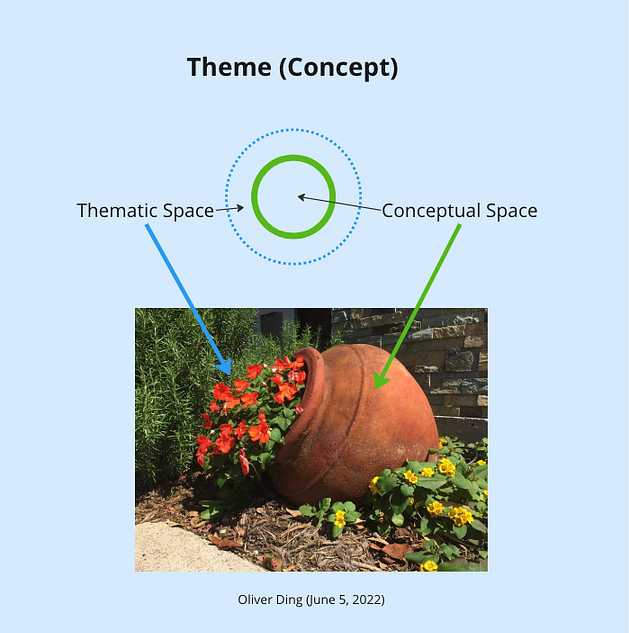
This represents a significant theoretical development achieved by TALE in 2023. It also had a profound impact on my creative journey, both in 2023 and beyond. It extended beyond the scope of TALE, influencing other knowledge centers I was involved with.
From January to June 2023, this period marked the first phase of TALE. In terms of the Creative Identity Engagement Framework, this phase corresponds to “Internal Integration.”

Later, TALE developed new strategic capacities and intellectual achievements from June 2023 to 2024.
In 2023, TALE was part of a network of seven knowledge centers.
- Curativity Center
- CALL (Creative Action Learning Lab)
- Activity Analysis Center
- Platform Ecology Center
- Life Strategy Center
- ARCH Center
- TALE (Thematic Analysis Learning Lab)
Each knowledge center is unique, acting as a collective project aimed at developing distinct knowledge. A “center” must have its own identity and theme to justify its existence; otherwise, there is no need to establish one.
I refer to this network as the “Value Circle.” While each knowledge center develops its own unique body of knowledge, they also support one another, contributing to the growth of the entire network. This interdependence forms the Value Circle.
What was TALE’s strategic position within the Value Circle? In 2023, I realized the significant role TALE played in building the network of knowledge centers. While TALE serves as the knowledge center for hosting the Thematic Engagement project, it also functions as a Thematic Transformation Hub for the entire network.
I coined the term “Thematic Transformation Hub” to emphasize TALE’s unique role in transforming experiences into themes, which are then developed into knowledge elements.
As a Thematic Transformation Hub, TALE utilized the Strategic Thematic Exploration framework and related methods to perform the following actions:
- Transform experiences into situational themes
- Connect situational themes to creative themes
- Transform creative themes into knowledge elements
- Curate knowledge elements into knowledge frameworks.
This process also employs tools such as possible themes, thematic cards, thematic network diagrams, and other resources from the Thematic Engagement Toolkit.
The concept of the “Thematic Transformation Hub” emerged from a series of mental moves between TALE and other knowledge centers. Initially, I referred to this creative action as “Collaborations.”
The first example is a mental move between TALE and CALL. See the diagram below.
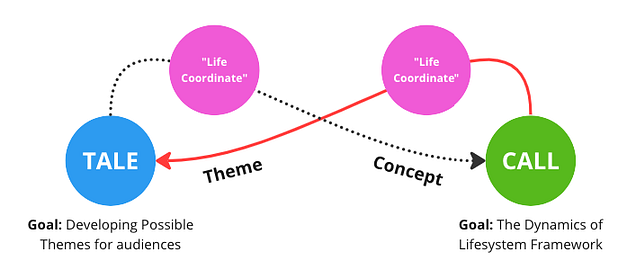
- CALL: “Life Coordinate” is a concept within the Lifesystem Framework (v1.0)
- CALL → TALE: “Life Coordinate” is detached from the Lifesystem framework (v1.0) and attached to TALE as an independent theme.
- TALE: “Life Coordinate” is an independent theme, now developed to v2.0.
- TALE → CALL: “Life Coordinate” is detached from TALE and reattached to CALL as a concept within the Lifesystem Framework (v2.0).
More details can be found in Value Circle #3: TALE as A Thematic Transformation Hub.
In this stage, TALE discovered its unique identity within a network of connected knowledge centers, marking the second phase of TALE. In terms of the Creative Identity Engagement Framework, this phase corresponds to "External Alignment."

In April 2024, I reviewed the landscape of TALE and the other knowledge centers. I noticed an interesting distinction: while each of the other knowledge centers has a unique theoretical approach as its high-level creation, TALE primarily consists of a toolkit and a series of knowledge frameworks.
At the end of 2024 and into early 2025, as I moved the Theme(Concept) model to the Concept Dynamics Center, I decided to assign Thematic Space Theory to TALE to support its future development.

A Thematic Space refers to a cognitive space where a person’s ideas, activities, and practices revolve around one particular theme. A theme can be an established theory, such as “Activity Theory,” a general concept such as “Platform” or “Life,” or an idea somewhere in between, such as “Design Thinking” or “UX.”
Initially, the concept was created as a theme to guide the development of a canvas for discussing the development of tacit knowledge in January 2022.
From 2023 onward, it evolved into a theoretical concept.
In 2024, I took it one step further, developing it as an independent theory, separate from Curativity Theory.
In 2025, TALE became the home of Thematic Space Theory.
This marked the third phase of TALE. In terms of the Creative Identity Engagement Framework, this phase corresponds to “Work Deeply.”
The TALE case study illustrates that identity development is not a linear process. As noted above, both the Creative Identity Engagement Framework and the Creative Thematic Curation Framework outline five movements that represent the journey of project engagement. Together, these movements provide a foundational model for understanding how a series of projects can form a meaningful whole.
Moreover, the Creative Thematic Curation Framework employs the notions of First Wave, Second Wave, and Third Wave to describe the dynamics of project engagement, particularly within multi-project journeys. This approach can also be applied to the Creative Identity Engagement Framework. For instance, the three phases of TALE described above can be interpreted as three weaves of identity development.
6. Case Study: TALE, Activity Analysis Center, and Curativity Center (2023)
As described in the previous case study, TALE was developed as a Thematic Transformation Hub.
On March 29, 2023, I published a post on TALE’s website titled TALE: A Possible Theme called “Expansive Activity Analysis”.

The article suggested a multi-level approach to design and innovation, later named Expansive Activity Analysis. This article can be understood as a proposal from TALE (see diagram below).
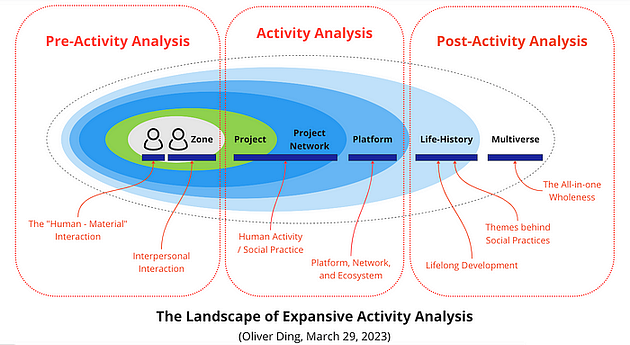
Within the proposal, I used the terms “Pre-Activity Analysis” and “Post-Activity Analysis” to label certain units of analysis. I then framed all these units into a coherent whole, naming it Expansive Activity Analysis, thereby creating a meta-framework for curating knowledge frameworks.
The Expansive Activity Analysis meta-framework was intended to curate knowledge frameworks according to situational needs, without being tied to any specific theoretical approach or to the traditional frameworks of Activity Theory. In the proposal, I applied the meta-framework to organize my own creations related to Activity Theory. More details can be found in TALE: A Possible Theme called “Expansive Activity Analysis”.
From March to September 2023, the Expansive Activity Analysis framework was not published on the Activity Analysis Center’s official website, which can be interpreted as a form of rejection by the center. The reason was that the framework, based on the rhetorical terms “Pre-Activity Analysis” and “Post-Activity Analysis,” did not make a distinctive contribution to the development of Activity Analysis.
From the perspective of Activity Analysis Center, there is a deep conflict between the perspective of “Actor” and the perspective of “Activity”. While traditional theoretical approaches focus on “Activity,” my creations always emphasize “Actor.”
The conflict was solved by Curativity Center in Sept 2023.
This tension was resolved by the Curativity Center in September 2023. On September 25, 2023, I developed a model for the Activity Analysis & Intervention (AAI) program (see diagram below), defining three types of activities within the project:
- First-order Analysis: Consultant → Client
- Activity Intervention: Consultant → Client
- Second-order Analysis: Coach → Consultant
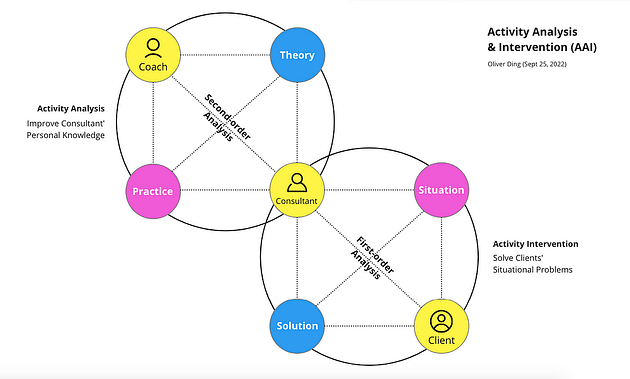
This model brought a new significance to the term Activity Analysis, allowing it to be treated as a theoretical concept and as the basis for developing a novel method. Previously, the term had not been used as a unique theoretical construct.
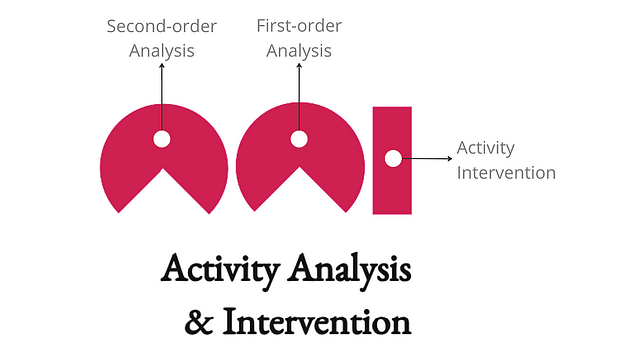
Previously, the term had not been used as a unique theoretical construct.
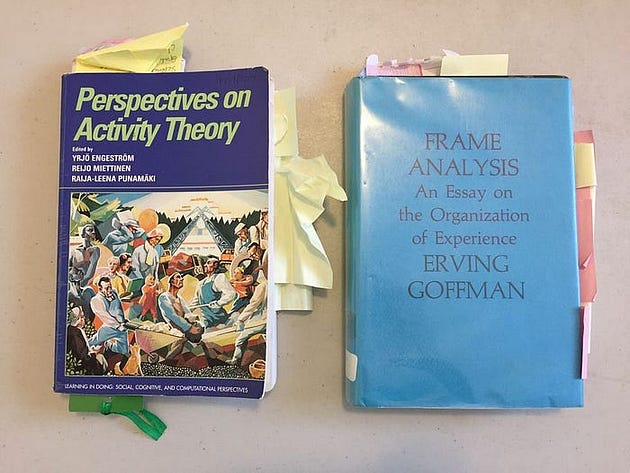
The Activity Analysis website represents an upgraded version of the previous Activity U project, itself a knowledge curation project under CALL. The website’s name draws inspiration from two sources: “Activity” from Perspectives on Activity Theory and “Analysis” from Frame Analysis. The site is designed for individuals interested in studying human activities and reflecting on their own daily lifeworlds using theoretical perspectives.
The distinctions of First-order Analysis and Second-order Analysis introduced new meaning to the concept of Activity Analysis.
The new method of Activity Analysis was inspired by Eric Berne’s Transactional Analysis, in which social interactions (or “transactions”) are analyzed to understand the communicator’s ego state (parent-like, child-like, or adult-like).
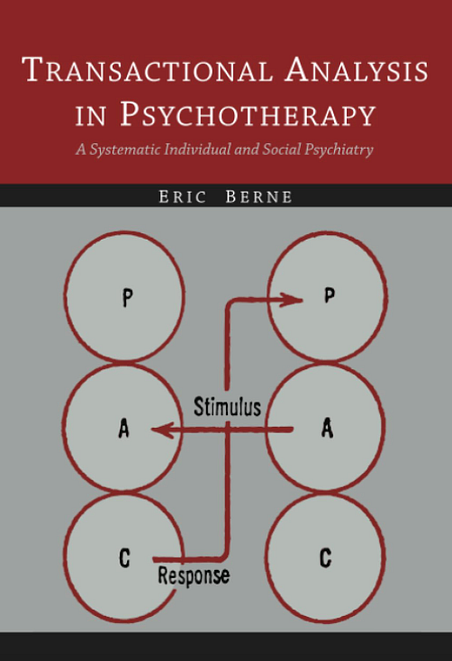
Analogously, my method uses Activity Analysis to develop a person’s tacit knowledge—including the Self, Mind, Life, Mindset, and related capacities—through analysis of their activities. More details can be found in Situational Note-taking: First-order Analysis and Second-order Analysis and Knowledge Engagement: The Concept of “Activity”.
On September 29, 2023, I published The Activity Analysis & Intervention (AAI) Project on Activity Analysis Center’s website.
The center accepted Curativity Center’s AAI framework but had previously rejected TALE’s Expansive Activity Analysis proposal. This distinction reflects the identity of the Activity Analysis Center, which is grounded in the concept of Activity Analysis: TALE’s framework lacked a substantive theoretical foundation, whereas AAI provided new meaning and methodological rigor through First- and Second-order Analysis.
Later, I discovered a spatial mapping between the basic model of Project-oriented Activity Theory and the AAI program, inspiring the design of a new logo for the Activity Analysis Center.
The old 2022 logo featured a red circle symbolizing a meaningful whole: Activity.

The new logo incorporates double circles: a red circle representing Activity and a blue circle representing Knowledge.

This design conveys the essential message that the Activity Analysis Center focuses not only on Activity Theory but also on the Knowledge behind Activity, capturing the core meaning of “Activity Analysis.”
These three events can be visualized using the Creative Identity Engagement Model: the first two represent External Alignment, while the third corresponds to Internal Integration.
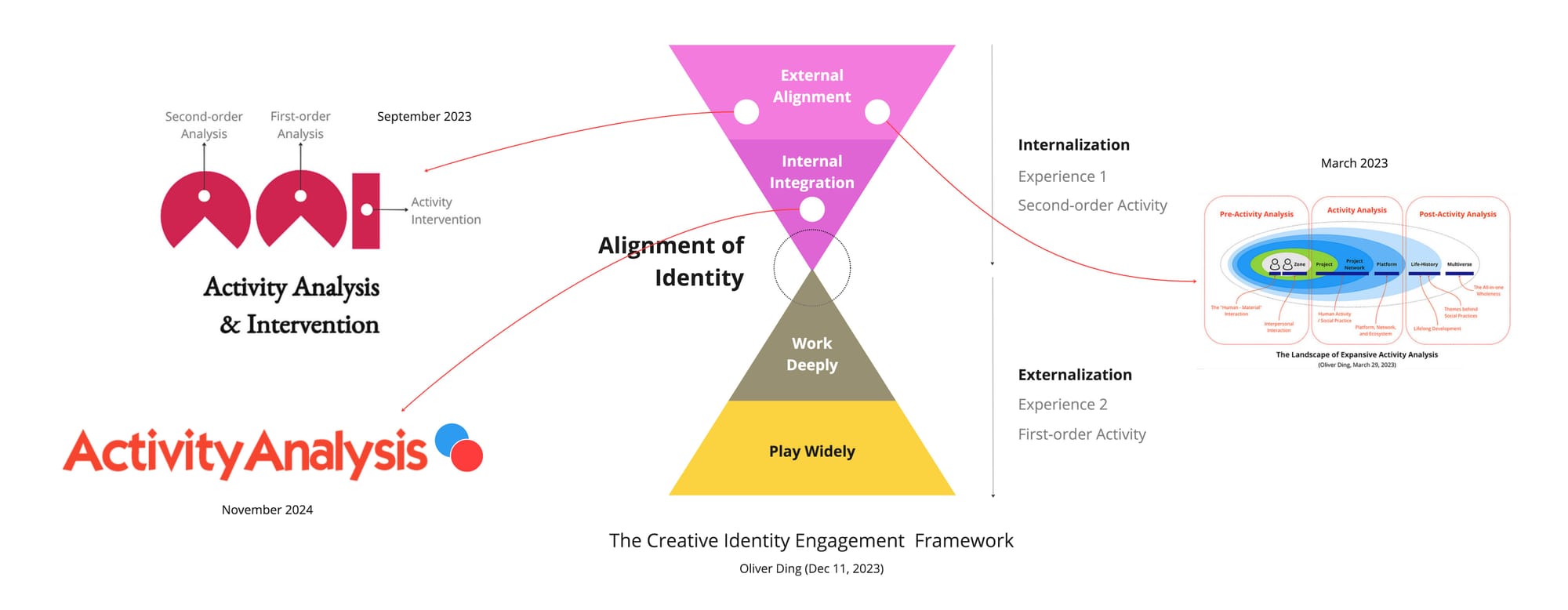
Further details are discussed in Value Circle #8: Proposal, Request, and External Alignment and Knowledge, Activity, and Development.
7. Case Study: CALL (Creative Action Learning Lab) - 2022
As an independent knowledge center, CALL (Creative Action Learning Lab) hosts two knowledge enterprises: Creative Life Theory and the Ecological Practice Approach.
The Ecological Practice Approach was inspired by James J. Gibson’s Ecological Psychology, Roger Barker’s Behavior Settings Theory, Urie Bronfenbrenner’s Ecology of Human Development, and various practice theories. It was defined as a meta-theory. Over the past years, I have developed a series of knowledge frameworks under this approach.
In early 2022, I identified a conflict between two of its members: the Infoniche framework and the Lifesystem framework. In this section, I will focus on these two frameworks to conduct a case study of internal integration within a knowledge system.
7.1 The Ecological Practice Approach
On August 15, 2023, I used the Knowledge Discovery Canvas to represent the landscape of the Ecological Practice Approach.

Approaches
- The Ecological Practice Approach
Concepts
- Affordance
- Supportance
- Curativity
- Container (Containee)
- Themes of Practice
- Attachance
- Genidentity
Perspectives
- The Attach — Container — Detach Flow
- The Subject — Potential — Object Focus
- The Affordance — Attachance Chain
- The Affordance — Supportance Loop
- The Affordance — Supportance Cycle
- The Ecological Zone
- The X — Y — Z Echo
- The Network — Container — Platform Move
Frameworks
- Ecological Transformation
- Infoniche Framework
- Lifesystem Framework
- SET (Structured Engagement Theory) Framework
- Platform Genidentity Framework
Methods
- Ecological Physical Method
- Ecological Interaction Analysis
- Creative Action Analysis
Heuristics
- Creative Work Canvas
- City Discovery Canvas
- The Shaman’s Mandala
- The Opportunity Formula
Domains
- Hardware
- Software
- Mindware
Further details can be found in The Ecological Practice Design Toolkit (V2, 2023).
Over the past years, I have developed several frameworks for different purposes (see diagram below).

- Ecological Transformation Framework (link: 1, 2)
- Infoniche Framework (link: 1, 2, 3)
- Lifesystem Framework (link: 1, 2)
- SET (Structured Engagement Theory) Framework (link: 1)
- Platform Genidentity Framework (link: 1)
The case study will focus on the Infoniche framework and the Lifesystem framework.
7.2 The Infoniche Framework
The Infoniche Framework was first introduced in my 2020 book (draft) titled After Affordance: The Ecological Approach to Human Action. After reviewing Gibson’s concept of Niche, Barker’s Behavior Settings, and Urie Bronfenbrenner’s Bioecological Systems, I coined the term Infoniche and developed a framework for analyzing ecological niches in the information age.
The term “niche” originates from ecology, but Gibson redefined it from the perspective of ecological psychology. According to Gibson, “Ecologists have the concept of a niche. A species of animal is said to utilize or occupy a certain niche in the environment. This is not quite the same as the habitat of the species; a niche refers more to how an animal lives than to where it lives. I suggest that a niche is a set of affordances. The natural environment offers many ways of life, and different animals have different ways of life. The niche implies a kind of animal, and the animal implies a kind of niche. Note the complementarity of the two. But note also that the environment as a whole with its unlimited possibilities existed prior to animals. The physical, chemical, meteorological, and geological conditions of the surface of the earth and the pre-existence of plant life are what make animal life possible. They had to be invariant for animals to evolve.” (1979/2015, pp.120–121)
Following Gibson’s definition of niche, I coined a new term, Infoniche, which was defined as a set of potential action possibilities, such as affordances and supportances.
The prefix “info” indicates that this updated version of the niche concept aims to extend Gibson’s idea into the information age and digital environments. However, it is important to note that Infoniche does not refer solely to digital or information environments; it encompasses both traditional and digital environments. Moreover, the Infoniche Framework extends Gibson’s concept from the natural environment to the social environment by incorporating the concept of Supportance.
Unlike Roger Barker, Gibson did not develop a systematic analytical framework for his version of the niche. Inspired by Barker’s work on Behavior Settings, I developed a concrete analytical framework for applying the concept of Infoniche in empirical studies. The first version of the Infoniche Framework takes the form of a table (see picture below).
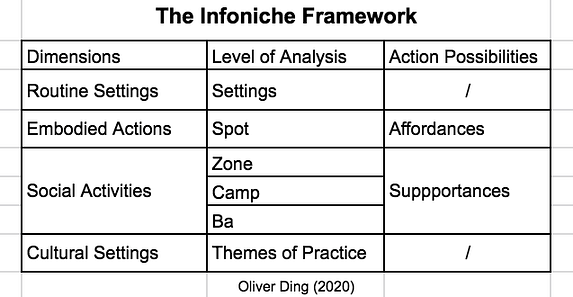
In 2021, I developed a new version of the framework (see the diagram below).
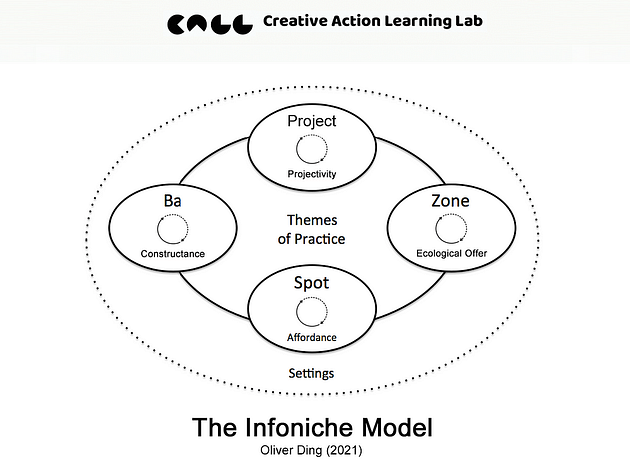
Both versions of the framework share the same underlying principle: defining units of analysis to study potential action possibilities. While the first version uses the units “Spot,” “Zone,” “Camp,” and “Ba,” the second version uses “Spot,” “Zone,” “Project,” and “Ba.”
Defining and selecting units of analysis are considered operational-level tasks. The differences between the first and second versions are therefore not substantial. In the future, additional units of analysis may be incorporated into the Infoniche Framework.
Further details can be found in The Infoniche Model.
7.3 The Lifesystem Framework
The Lifesystem Framework is a theoretical framework for applying the Ecological Practice Approach to the study of social practices.
In October 2020, the Lifesystem Framework was created by combining the Affordance — Supportance Loop with the Subject — Potential — Object Focus (see the diagram below).

Based on this model, I developed a set of operational concepts:
- Actor
- Group
- Intention
- Result
- Material
- Information
- Resource
- Reward
The resulting model is shown below.

These operational concepts guide the research and reflection aimed at understanding the structure and dynamics of Lifesystems. Further details can be found in Lifesystem: Modeling Ice Skating and Other Social Practices.
7.4 Detecting an Internal Conflict
In February 2022, I began developing a nine-module toolkit for the Life Discovery Activity.
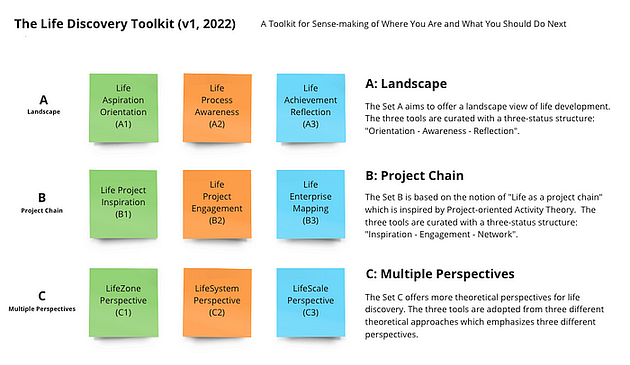
Set C of the toolkit offers three theoretical perspectives for life discovery:
- C1 — LifeZone Perspective: How do you interact with significant others?
- C2 — LifeSystem Perspective: How well do you adapt to environments?
- C3 — LifeScale Perspective: How do you echo the development of culture?
The Lifesystem framework was selected as C2.
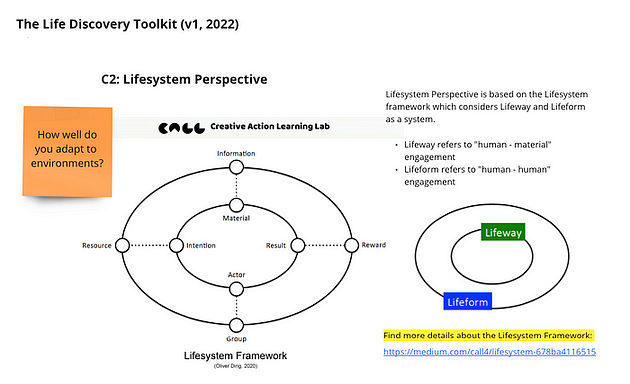
Further details can be found in The Life Discovery Toolkit (v1).
While developing the toolkit, I also compared the Lifesystem Framework with C1 (LifeZone Perspective) and C3 (LifeScale Perspective). The LifeZone Perspective is based on the iART framework, part of the Anticipatory Activity System framework. The LifeScale Perspective is based on the Landscape of Culture, which is part of Project-oriented Activity Theory. Given that these three frameworks have different theoretical foundations, I could clearly identify the distinctions among them.
This comparison inspired me to examine the Lifesystem Framework alongside the Infoniche Framework, as both emerge from the same theoretical approach. To my surprise, I discovered a significant difference between the two:
- The basic unit of the Lifesystem Framework is “Lifesystem,” used to understand human practice and social life.
- The basic unit of the Infoniche Framework is “Person–Environment,” used to discover potential action opportunities for the individual.
In February 2022, I asked myself the following question:
If I were to select only one of these frameworks to represent the Ecological Practice Approach, which would be the best choice?
This question is fundamentally about the “Identity” of the Ecological Practice Approach. The tension between the Infoniche Framework and the Lifesystem Framework reflects an internal conflict within the approach.
At that time, I did not have an answer.
7.5 Solving the Problem
On March 30, 2023, I applied the Thematic Exploration method to address the internal conflict. I detached the theme of “Life Coordinate” from the Lifesystem Framework (v1.0) and re-constructed its conceptual configurations. The revised version of “Life Coordinate” was then re-integrated into the Lifesystem Framework (v2.0).
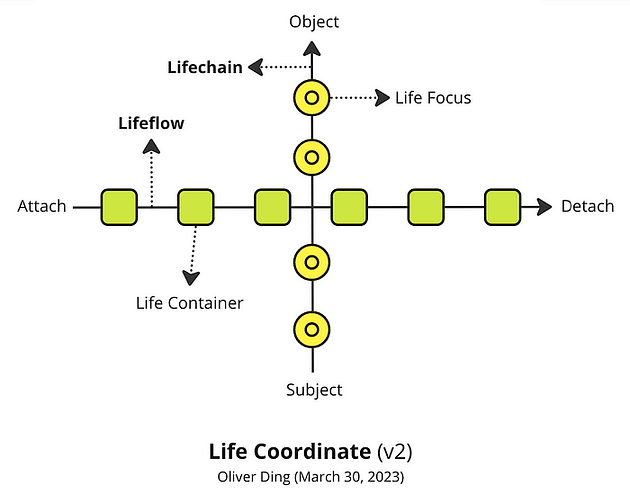
Considering the Ecological Practice Approach as a Knowledge System that could evolve into a Developmental Platform, we can use the Platform Genidentity Framework to understand the differences between the Infoniche Framework and the Lifesystem Framework (see diagram below).

CALL represents Creative Action Learning Lab, and AA represents Activity Analysis Center. They host different knowledge systems:
- CALL: The Ecological Practice Approach, inspired by Ecological Psychology.
- AA: The Activity Analysis Method, inspired by Activity Theory.
My concern regarding the internal conflict between the Infoniche Framework and the Lifesystem Framework relates to the Genidentity of the Ecological Practice Approach. As mentioned above, the approach is a large knowledge system containing different types of knowledge entities:
Some knowledge entities, such as primary concepts, are the Theoretical Foundations of the approach, and they define the Essential Differences between the approach and other theoretical approaches.
Some knowledge entities, such as practical knowledge frameworks, are the Theoretical Applications of the approach, and they offer solutions to adapt to Situated Dynamics.
The above diagram organizes five knowledge frameworks into different areas:
Primary Area:
- F1 (The Ecological Transformation Framework) is based on the concept of Attachance.
- F5 (Platform Genidentity Framework) is based on the concept of Genidentity.
Secondary Area:
- F2 (Infoniche Framework) is based on the concept of Infoniche.
Tertiary Area:
- F3 (Lifesystem Framework, v1.0) is based on Lifesystem/Lifeway/Lifeform and Subject/Object.
- F4 (SET, Structured Engagement Theory) is inspired by Activity Theory and Behavior Setting Theory.
Both F3 and F4 were developed using the Concept Curation method and were developed for empirical research and practical reflection.
The Lifesystem Framework (v2.0) should be placed in the Secondary Area, as it replaces Activity Theory’s “Subject–Mediation–Object” with “Subject–Potential(Actual)–Object.” Since the Subject–Object pair is commonly used in social sciences, this adjustment removes the weak link between Life Coordinate and Activity Theory.
It is also important to note that I do not consider concepts such as “Lifesystem,” “Lifeway,” “Lifeform,” “Lifeflow,” and “Lifechain” as primary concepts. These are treated as secondary concepts.
8. Case Study: HELLO THEORY (2024)
On October 18, 2024, as I reflected on the journey of moving from Creative Life to Strategic Life, an insight struck me:
…a path toward developing a comprehensive theory of human life: addressing one aspect at a time.
Immediately, I found a new name for the theory:
Human Experience and Life Learning Optimization
It stands for HELLO!
The first part, Human Experience, highlights the distinction between natural and social sciences, with my theoretical preference embracing subjective experience as an acceptable object of inquiry. In sociology, this draws from traditions such as Weber’s interpretive sociology, Schutz’s phenomenological sociology, and Ping-keung Lui’s subjectivist structuralism. Philosophically, William James’s radical empiricism has had a significant influence, underpinning core concepts in my development of the Ecological Practice approach. In terms of social research methodology, it emphasizes field-based qualitative approaches closely tied to actors’ experiences and includes reflective practices, autoethnography, life narrative, and more.
The middle term, Life Learning, emphasizes both Life and Learning, continuing the philosophy of CALL (Creative Action Learning Lab), which I founded in 2019. It regards the lifeworld as a dynamic field for learning and creativity.
Finally, Optimization reflects a proactive, excellence-oriented spirit, embodying key aspects of life: Creative, Strategic, Supportive, and Developmental.

I also began drafting a thesis to capture this journey from Creative Life to Strategic Life, integrating the concept of HELLO.
On October 21, 2024. I considered using the “HELLO THEORY” theme to name a new knowledge center.

I also made an informal semiotic system diagram to represent HELLO THEORY.
From October 21 to 24, I continued refining the thesis and updating both diagrams. The completed thesis, titled Human Life: From Creative Life Theory to Strategic Life Theory, is a 23-page document with eight sections:
- Five Years and Five Months
- Strategic Moves
- Reverse Takeover
- Reframing the Landscape
- Projecting and Engaging
- A Theory of Human Life
- HELLO THEORY
- Genidentity — Opportunity Theory
This thesis introduced the “HELLO THEORY” theme, inspiring a series of possible new projects.
- Possible Project #1: A New Meta-Center as a Creative Platform
- Possible Project #2: A Theoretical Curation Project
- Possible Project #3: A New Theory of Human Life
In Possible Project #1, which involves creating a new meta-center as a creative platform, the Creative Identity Engagement framework offers an effective structure for analysis.

The Creative Identity Engagement framework includes three primary phases:
- Phase 1: Internalization
- Phase 2: Alignment of Identity
- Phase 3: Externalization
8.1 External Alignment
The Phase 1 (Internalization) has two sub-phases:
- External Alignment: Identifying the differences and similarities between Our Project and others. This comparison helps establish the identity of the project.
- Internal Integration: Curating various internal connections to form a meaningful whole around the new identity. These connections include 1) the relationship between the current project and other internal projects, and 2) the diverse ideas and resources contributed by individual team members.
In External Alignment, “HELLO” defines its uniqueness by interpreting its brand name in the following way:
- HELLO stands for Human Experience and Life Learning Optimization
- Human Experience differentiates the project’s focus on subjective experience, drawing on Weber’s interpretive sociology, Schutz’s phenomenological sociology, Ping-keung Lui’s subjectivist structuralism, and James’s radical empiricism. In social research, this points to qualitative methodologies such as fieldwork, autoethnography, and life narrative.
- Life Learning continues the legacy of CALL (Creative Action Learning Lab), viewing the lifeworld as a dynamic field for learning and creation.
- Optimization reflects a drive for excellence and proactive development in creativity, strategy, support, and growth.
Moreover, the theme of “HELLO THEORY” refers to a creative dialogue between THEORY and CREATORS.
- HELLO THEORY: A Creator “saying hello” to THEORY!
This brand identity emphasizes the key part of Life Learning, the theory—practice connection. This is my mission behind the creative journey I have taken over the past five years.
8.2 Internal Integration
In Internal Integration, “HELLO” uses the following two models as Predictive Models to frame its future activities.
- The Knowledge Value Chain Model
- The Field of Meta-learning Model (meta-knowledge, knowledge, work)
The above trees show a simple structure, each knowledge center has its position and focus. They have different theoretical resources and knowledge creations as outcomes.
The “Meta-knowledge” group focuses on developing meta-knowledge such as thematic exploration, concept development, and knowledge framework.
The “Knowledge” group focuses on developing unique theoretical approaches by using specific theoretical resources.
The “Work” group focuses on applying the above two groups in specific fields and domains.
8.3 Alignment of Identity
The most pivotal stage, Phase 2: Alignment of Identity, shapes both the internalization and externalization processes. Here, the collective works to define a “New Identity of Our Project.”
For Possible Project #1, the network of knowledge centers can be viewed as a group. “Our Project’s Old Identity” aligns with Curativity Center’s identity, while the “New Identity” aligns with “HELLO.”
includes three primary phases:
- Phase 1: Internalization
- Phase 2: Alignment of Identity
- Phase 3: Externalization
The most pivotal stage, Phase 2: Alignment of Identity, shapes both the internalization and externalization processes. Here, the collective works to define a “New Identity of Our Project.”
For Possible Project #1, the network of knowledge centers can be viewed as a group. “Our Project’s Old Identity” aligns with Curativity Center’s identity, while the “New Identity” aligns with “HELLO.”
Since 2019, I have managed my knowledge enterprises through the “Knowledge Center” approach.
- 2019 to 2022: CALL served as an incubator, giving rise to five knowledge centers. The Curativity Center emerged from this phase.
- June 2, 2022: CALL and Curativity Center switched roles, with Curativity Center becoming a meta-center focused on building a network of knowledge centers.

Curativity Center’s visual identity draws on elements from its predecessor, CALL. These design elements serve as a foundation for the other knowledge centers’ visual identities. See the examples below.

While Curativity Center acted as the meta-center from 2022 to 2023, the network of knowledge centers was not structured hierarchically, with Curativity at the top. See the diagram below.

To run the network effectively, I set a guideline: each knowledge center would host only one major knowledge enterprise. However, as Curativity Center was dedicated specifically to Curativity Theory, it became clear that it might not be ideal as the overarching meta-center.
On October 21, 2024, the theme “HELLO THEORY” caught my attention, and I immediately considered it as a fitting name for the new meta-center. The next day, I structured a new version of the knowledge center network, shown in the diagram below.

For simplicity, the 2024 structure uses the Field of Meta-learning, which defines three primary levels: meta-knowledge, knowledge, and work. This resonates well with the landscape of my knowledge enterprises, as a significant part revolves around meta-knowledge — knowledge about creating knowledge.
Since 2022, I have often used the theme “Knowledge Engagement” to describe my mission of connecting THEORY and PRACTICE.
However, for broader appeal, the theme “HELLO THEORY” presents a clearer, more accessible message about theory-driven knowledge engagement.
In this way, the mission of connecting THEORY with PRACTICE remains, but now with a more approachable name.
“HELLO” changes both in visual identity design and the structure of the group of knowledge centers.
8.4 Externalization
The Phase 3 (Externalization) of the Creative Identity Engagement framework has two sub-phases:
- Work Deeply: Focuses on internal work related to the new identity, emphasizing collaboration within the team.
- Play Widely: Focuses on external activities involving the new project identity, where consumers or other stakeholders become central to the project’s activities.
The theme “HELLO” is still in its early stages and has yet to reach Phase 3.
9. Multiple-wave Development
The Creative Identity Engagement framework was developed to support the Developmental Project Model and follows a similar spatial structure to the Creative Life Curation framework.
In addition to a five-movement model, the Creative Life Curation framework also incorporates multiple-wave development to track the dynamics within these movements.

More details can be found in Slow Cognition: The Creative Life Curation Framework.
Let’s see an example. The diagram below is the first-wave development of “Creative Life Theory”.

The diagram below shows the second-wave development of “Creative Life Theory”.

The diagram below shows the third-wave development of “Creative Life Theory”.

The multiple-wave development pattern can also be applied to the Creative Identity Engagement framework.
My network of knowledge enterprise has been assigned three meta-centers:
- 2020–2022: CALL
- 2022–2024: Curativity Center
- 2024: HELLO
In 2020, CALL transitioned into a knowledge curation studio, producing various knowledge frameworks and fostering a network of ideas. This era yielded seven book drafts and four independent research projects designed to test concepts and frameworks.

Inspired by Howard E. Gruber’s Evolving Systems Approach to Creative Work, I implemented his “Network of Enterprise” concept to manage creative endeavors in 2020. CALL’s frameworks were categorized into seven enterprises:
- CALL for ECHO → Boundary Innovation
- CALL for LIFE → Creative Life
- CALL for NICE → Creative Action
- CALL for NEST → Part — Whole
- CALL for DEEP → Supportive Development
- CALL for NEXT → Present — Future
- CALL for META → Meta-knowledge
Each enterprise has its primary theme. Each theme refers to a core framework and a set of related concepts, diagrams, and sub-frameworks.
This was the first-wave development of a “Creative Identity Engagement” journey!
In 2022, I used a new approach to manage my knowledge enterprise. See the diagram below.

The model was inspired by Project-oriented Activity Theory. Each phase refers to a focus. In 2022, my creative journey moved to the second phase: Building Knowledge Centers.
In March 2023, I used the diagram below to present a network of knowledge centers.

From June 2022 to March 2023, I did three things.
- I built six knowledge centers. It is a network of knowledge centers.
- I developed a set of tools for understanding the complexity of knowledge centers
- I developed a systematic theoretical approach to Creative Life and wrote four books.
The concept of “Knowledge Center” became a project of my creative journey. More details can be found in TALE: A Possible Theme called “Knowledge Center” and Center, Circle, and Genidentity (book, v1, 2024).
This was the Second-wave development of a “Creative Identity Engagement” journey!
The theme of “HELLO” inspired the possible third-wave development, focusing on developing a Creative Platform.
This case study was conducted in October 2024. Over the following months, I paid less attention to the network of connected knowledge centers and instead focused on individual knowledge projects and enterprises—for example, the Knowledge Strategy series, the World of Activity Approach, and Creative Life Theory (v3.1).
Recently, in October 2025, I returned to the Activity Analysis Center and designated it as the meta-center for the period 2025–2026.
In May 2025, I conducted a case study on the identity development of the Activity Analysis Center from 2022 to 2025. In this case study, I summarized five types of change that impact the center:
- Center Development (The Activity Analysis Center)
- Concept Development (The Concept of “Knowledge Center”)
- Enterprise Development (The “Curativity” Thematic Enterprise)
- Academic Development (The “Activity Theory” Community)
- Practical Development (The “LinkedIn Professionals” Community)

Center Development refers to the internal changes of the Activity Analysis Center. These changes can be understood through the evolving knowledge enterprise mode, which highlights three dimensions across three hierarchical levels:
- The Transformation of Knowledge Elements
- The Activity of Knowledge Engagement
- The Materiality of Knowledge Representation
The other four types of development represent external dynamics that reshape how I understand and operate the Activity Analysis Center and its context.
For example, I used the Project Engagement approach to develop a framework to explain the concept of “Knowledge Center” and to guide the practice of building a knowledge center. Since the approach was inspired by Activity Theory, I considered it to be the primary object of the Activity Analysis Center. This forms a self-referential activity.
However, later, I adopted other knowledge frameworks to explain the concept of “Knowledge Center” and to guide the practice of building a knowledge center. This move extended beyond the scope of the Activity Analysis Center.
Since the field of Activity Theory is not fixed to one theoretical approach, maintaining the relationship between the Activity Analysis Center and the “Activity Theory” community is a significant challenge. Each time I discovered a new approach to the theory of ‘Activity,’ it changed my understanding of the field and the community, and inspired creative actions to revise my knowledge frameworks.
Also, the development of my other knowledge enterprise and the feedback from the “LinkedIn Professionals” community impact the development of the Activity Analysis Center.
The diagram below summarizes the key insights generated from this case. One notable discovery is that the Genidentity of Knowledge System model can serve as a structural support for the Creative Identity Engagement framework.

In Phase 1 (Internalization) of the Creative Identity Engagement framework, I defined two sub-phases:
- External Alignment: Identifying the differences and similarities between Our Project and other projects. This comparison helps shape the project’s emerging identity.
- Internal Integration: Curating internal connections to form a meaningful whole around the new identity. These connections include 1) relationships between the current project and other internal projects, and 2) the diverse ideas and resources contributed by individual team members.
In the journey of the Activity Analysis Center, we encountered a particularly complex case. To draw the boundary between internal and external activities, we first needed to define what the project itself actually was.
But what, ultimately, is the “true” project behind the Activity Analysis Center?
The answer emerges through the lens of the Creative Thematic Curation framework, which describes how a central theme and concept for a knowledge enterprise takes form. See the left section of the diagram above.
Over the years, the Activity Analysis Center has transformed a thematic network, including the following themes, into a more integrated conceptual system:
- The theme of “Activity Analysis”
- The theme of “Project Engagement”
- The theme of “World of Activity”
- The theme of “Activity”
From 2022 to 2024, I explored new meanings for these themes. At the end of 2024, the journey reached a turning point with the launch of the new logo for the Activity Analysis Center and the World of Activity Toolkit (v1, 2024).
These exploratory decisions can be mapped using the Genidentity of Knowledge System model, which defines three structural areas:
- Primary Area
- Secondary Area
- Tertiary Area
Creative Dialogues between Activity Theory and other theories generate outcomes that correspond to these areas, influencing the development of the knowledge system as a whole. Other types of activity can also be mapped using this structure:
- The Activity Analysis Center’s website → Primary Area
- The Synergy Effects within the “Curativity” Thematic Enterprise → Secondary Area
- The Peer Support from the “LinkedIn Professional” community and the “Activity Theory” community → Tertiary Area
This mapping suggests that the sub-phase of External Alignment may be conceptualized through a “Center–Periphery” image schema. The Genidentity of Knowledge System model offers a three-zone operational structure to analyze this complexity. In other cases, we may require more zones to account for more layered center–periphery dynamics.
Because this case describes a solo-operated center, the Internal Integration process remains relatively simple. However, in larger collaborative settings, we may encounter more intricate internal dynamics.
In [Wonder and Wander] The Aion Journey (2021–2025), I defined Time Curation as a meta-curation process that supports Enterprise Curation. Based on the current case study, we can now also define Space Curation as a complementary meta-curation process — one that focuses primarily on the identity development of a knowledge enterprise.
In this way, the Journey of Project Engagement model, the Genidentity of Knowledge System model, and the Creative Identity Engagement framework come together to form a composite approach — an emergent method for understanding the art of Space Curation.
The full case study can be found in [Wonder and Wander] The Center Journey (2022–2025, Part A) and Part B.
v1.0 - 8,773 words - November 12, 2025
